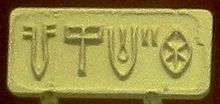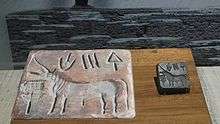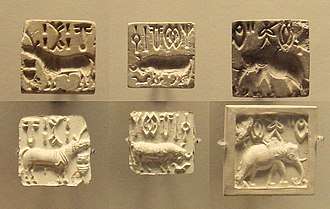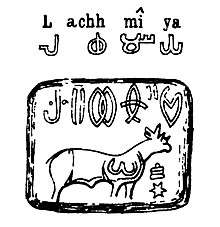Indus script
The Indus script (also known as the Harappan script) is a corpus of symbols produced by the Indus Valley Civilization. Most inscriptions containing these symbols are extremely short, making it difficult to judge whether or not these symbols constituted a script used to record a language, or even symbolise a writing system.[4] In spite of many attempts,[5] the 'script' has not yet been deciphered, but efforts are ongoing. There is no known bilingual inscription to help decipher the script, and the script shows no significant changes over time. However, some of the syntax (if that is what it may be termed) varies depending upon location.[4]
| Indus script | |
|---|---|
 Seal impression showing a typical inscription of five characters | |
| Type | Undeciphered possible Bronze Age writing
|
| Languages | Unknown (see Harappan language) |
Time period | 3500–1900 BCE[1][2][3] |

The first publication of a seal with Harappan symbols dates to 1875, in a drawing by Alexander Cunningham.[6] Since then, over 4,000 inscribed objects have been discovered, some as far afield as Mesopotamia, as a consequence of ancient Indus-Mesopotamia relations. In the early 1970s, Iravatham Mahadevan published a corpus and concordance of Indus inscriptions listing 3,700 seals and 417 distinct signs in specific patterns. He also found that the average inscription contained five symbols and that the longest inscription contained only 26 symbols.[7]
Some scholars, such as G.R. Hunter,[8] S. R. Rao, John Newberry[9] and Krishna Rao[10] have argued that the Brāhmī script has some connection with the Indus system. F. Raymond Allchin has somewhat cautiously supported the possibility[11][12] of the Brahmi script being influenced by the Indus script.[13] Another possibility for continuity of the Indus tradition is in the megalithic culture graffiti symbols of southern and central India (and Sri Lanka), which probably do not constitute a linguistic script but may have some overlap with the Indus symbol inventory.[14][15] Linguists such as Iravatham Mahadevan, Kamil Zvelebil and Asko Parpola have argued that the script had a relation to a Dravidian language.[16][17]
Corpus

Early examples of the symbol system are found in an Early Harappan and Indus civilisation context, dated to possibly as early as the 35th century BCE.[18][19] In the Mature Harappan period, from about 2600 BCE to 1900 BCE, strings of Indus signs are commonly found on flat, rectangular stamp seals as well as many other objects including tools, tablets, ornaments and pottery. The signs were written in many ways, including carving, chiseling, painting and embossing, on objects made of many different materials, such as soapstone, bone, shell, terracotta, sandstone, copper, silver and gold.[20] Often, animals such as bulls, elephants, rhinoceros, water buffaloes and the mythical unicorn accompanied the text on seals to help the illiterate identify the origin of a particular seal.[21]
Late Harappan
Bhit Dwarka
During under water excavation at Late Harappan site of Bet Dwarka, a seven sign inscription was discovered inscribed on a pottery jar. The inscription is dated to 1528 BC and consists of linear signs compared with the logographic Indus script. According to S.R Rao, the four out of seven signs show similarity with the Brahmi letters cha, ya, ja, pa or sa respectively. The script is also written from left to right just like brahmi script.[22]
Jhukar Phase, Sindh
Jhukar phase is the late Harappan phase in present province of Sindh which followed the mature urbanized Harappan phase. Although seals from this phase lack the Indus script which characterized the preceding phase of the civilization. some potsherd inscriptions have been noted.[23]
Daimabad, Maharashtra
Indus inscribed seals and potsherds have been noted at Daimabad in its late Harappan and Daimabad phase dated 2200-1600 BC.[24]
Characteristics
The characters are largely pictorial but include many abstract signs. The inscriptions are thought to have been written mostly from right-to-left (because there are several instances of the symbols being compressed on the left side, as if the writer is running out of space at the end of the row there), but they sometimes follow a boustrophedonic style. The number of principal signs is about 400. Since that is considered too large a number for each character to be a phonogram, the script is generally believed to instead be logo-syllabic.
Decipherability question


An opposing hypothesis that has been offered by Michael Witzel and Steve Farmer, is that these symbols are nonlinguistic signs, which symbolise families, clans, gods, and religious concepts and are similar to components of coats of arms or totem poles.[25] In a 2004 article, Farmer, Sproat, and Witzel presented a number of arguments stating that the Indus script is nonlinguistic. The main ones are the extreme brevity of the inscriptions, the existence of too many rare signs (which increase over the 700-year period of the Mature Harappan civilization) and the lack of the random-looking sign repetition that is typical of language.[26]
Asko Parpola, reviewing the Farmer, Sproat, and Witzel thesis in 2005, stated that their arguments "can be easily controverted".[27] He cited the presence of a large number of rare signs in Chinese and emphasised that there was "little reason for sign repetition in short seal texts written in an early logo-syllabic script". Revisiting the question in a 2007 lecture,[28] Parpola took on each of the 10 main arguments of Farmer et al., presenting counterarguments for each.
A 2009 paper[29] published by Rajesh P N Rao, Iravatham Mahadevan and others in the journal Science also challenged the argument that the Indus script might have been a nonlinguistic symbol system. The paper concluded that the conditional entropy of Indus inscriptions closely matched those of linguistic systems like the Sumerian logo-syllabic system, Rig Vedic Sanskrit etc., but they are careful to stress that by itself does not imply that the script is linguistic. A follow-up study presented further evidence in terms of entropies of longer sequences of symbols beyond pairs.[30] However, Sproat claimed that there existed a number of misunderstandings in Rao et al., including a lack of discriminative power in their model, and argued that applying their model to known non-linguistic systems such as Mesopotamian deity symbols produced similar results to the Indus script. Rao et al.'s argument against Sproat's claims and Sproat's reply were published in Computational Linguistics in December 2010.[31] The June 2014 issue of Language carries a paper by Sproat that provides further evidence that the methodology of Rao et al. is flawed.[32] Rao et al.'s rebuttal of Sproat's 2014 article and Sproat's response are published in the December 2015 issue of Language.[33][34]
Attempts at decipherment
Over the years, numerous decipherments have been proposed, but there is no established scholarly consensus.[35] The few points on which there exists scholarly consensus are the right-to-left direction of the majority of the inscriptions, numerical nature of certain stroke-like signs, functional homogeneity of certain terminal signs, and some generally adopted techniques of segmenting the inscriptions into initial, medial and terminal clusters.[36] The following factors are usually regarded as the biggest obstacles for a successful decipherment:
- The underlying language has not been identified though some 300 loanwords in the Rigveda are a good starting point for comparison.[37][38]
- The average length of the inscriptions is less than five signs, the longest being only 26 signs long,[39] although recent findings have revealed copper plates belonging to the mature Harappan period, one of them having 34 characters inscribed onto it.[40]
- No bilingual texts (like a Rosetta Stone) have been found.
The topic is popular among amateur researchers, and there have been various (mutually exclusive) decipherment claims.[41]
Dravidian hypothesis

The Russian scholar Yuri Knorozov suggested, based on computer analysis, a Dravidian language as the most likely candidate for the underlying language of the script.[42] Knorozov's suggestion was preceded by the work of Henry Heras, who also suggested several readings of signs based on a proto-Dravidian assumption.[43]
The Finnish scholar Asko Parpola wrote that the Indus script and Harappan language "most likely belonged to the Dravidian family".[44] Parpola led a Finnish team in the 1960s-80s that, like Knorozov's Soviet team, worked towards investigating the inscriptions using computer analysis. Based on a proto-Dravidian assumption, the teams proposed readings of many signs. A number of people agreed with the suggested readings of Heras and Knorozov. One such reading was legitimised when the Dravidian word for both 'fish' and 'star', "min" was hinted at through drawings of both the things together on Harappan seals.[45] A comprehensive description of Parpola's work until 1994 is given in his book Deciphering the Indus Script.[46]
Iravatham Mahadevan, another scholar who supported the Dravidian hypothesis, said "we may hopefully find that the proto-Dravidian roots of the Harappan language and South Indian Dravidian languages are similar. This is a hypothesis [...] But I have no illusions that I will decipher the Indus script, nor do I have any regret".[47] Commenting on his 2014 publication Dravidian Proof of the Indus Script via The Rig Veda: A Case Study, Mahadevan claimed to have made significant progress in deciphering the script as Dravidian.[48] According to Mahadevan, a stone celt discovered in Mayiladuthurai (Tamil Nadu) has the same markings as that of the symbols of the Indus script. The celt dates to early 2nd millennium BCE, post-dating Harappan decline. Mahadevan considered this as evidence of the same language being used by the neolithic people of south India and the late Harappans.[49][50] This hypothesis was also supported by Rajesh P. N. Rao[51][52] [53]
In May 2007, the Tamil Nadu Archaeology Department found pots with arrow-head symbols during an excavation in Melaperumpallam near Poompuhar. These symbols are claimed to have a striking resemblance to seals unearthed in Mohenjo-daro in present-day Pakistan in the 1920s.[54] In Sembiyankandiyur a stone axe was found, claimed to be containing Indus symbols. In 2014, a cave in Kerala was discovered with 19 pictograph symbols claimed to be containing Indus writing.[55]
In 2019, excavations at the Keezhadi site near present-day Madurai unearthed potsherds with graffiti, which were dated to 580 BCE.[56][lower-alpha 1] In a report, the TN Archaeology Dept. said the graffiti bore numerous similarities to known Harappan symbols, and so could be a transitional script between Indus Valley script and the Tamil Brahmi script used during the Sangam Period.[57]
Sanskritic hypothesis
Indian archaeologist Shikaripura Ranganatha Rao claimed to have deciphered the Indus script. He compared it to the Phoenician alphabet, and assigned sound values based on this comparison. His decipherment results in a "Sanskritic" reading, including the numerals aeka, dwi, tra, chatus, panta, happta/sapta, dasa, dvadasa, sata (1, 2, 3, 4, 5, 7, 10, 12, 100).[58] He also noted a number of striking similarities in shape and form between the late Harappan characters and the Phoenician letters, arguing that the Phoenician script evolved from the Harappan script, and not, as the classical theory suggests from the Proto-Sinaitic script.[59]
John E. Mitchiner dismissed some of these attempts at decipherment. Mitchiner mentioned that "a more soundly-based but still greatly subjective and unconvincing attempt to discern an Indo-European basis in the script has been that of Rao".[60]
Miscellaneous hypotheses
There have been several hypotheses regarding the language pertaining to the Indus Script. One of the most common ones has been that the script belongs to the Indo-Aryan language. However, there are many problems with this hypothesis. A major one includes: Since the people belonging to the Indo-European cultures were always on the move, horses played a very important role in their lives or as Parpola put it, "There is no escape from the fact that the horse played a central role in the Vedic and Iranian cultures..." (Parpola, 1986).
A second, though not as popular hypothesis is that the Indus script belongs to the Munda family of languages. The Munda family of languages is spoken largely in Eastern India, and is related to some and Southeast Asian languages. However, much like the Indo-Aryan language, the reconstructed vocabulary of early Munda does not reflect the Harappan culture. Therefore, its candidacy for being the language of the Indus Civilization is dim.[66]
Similarities with Linear Elamite
Scholars have also compared the Indus valley script with the Linear Elamite writing system used in Elam, an ancient Pre-Iranian civilization that was contemporaneous with the Indus Valley civilization. The two languages were contemporary to each other. Scholars gained knowledge of the Elamite language from a bilingual monument called the "Table of the Lion" in the Louvre museum. On comparing this ancient language to the Indus script, a number of similar symbols have been found.[67]
Encoding
The Indus symbols have been assigned the ISO 15924 code "Inds". The script was proposed for encoding in Unicode's Supplementary Multilingual Plane in 1999; however, the Unicode Consortium still lists the proposal in pending status.[68] At the International Conference on Mohenjodaro and Indus Valley Civilisation 2017 it was noted that two language engineers, Amar Fayaz Buriro and Shabir Kumbhar have engineered all 1839 signs of Indus script and presented a developed Indus script font.[69][70]
See also
- Related topics
- Megalithic graffiti symbols
- Ancient iron production
- Brahmi script
- Bronze Age writing
- History of metallurgy in South Asia
- Proto-writing
- Undeciphered scripts
- Lipi
- Stambha
- Other similar topics
- Ashokan Edicts in Delhi
- Ashoka's Major Rock Edicts
- Dhar iron pillar
- Early Indian epigraphy
- Hindu temple architecture
- History of India
- Indian copper plate inscriptions
- Indian rock-cut architecture
- Iron pillar of Delhi
- List of Edicts of Ashoka
- List of rock-cut temples in India
- Outline of ancient India
- Pillars of Ashoka
- South Indian Inscriptions
Notes
- David Whitehouse (May 4, 1999). "'Earliest writing' found". BBC News. Retrieved 2 September 2014.
- "Evidence for Indus script dated to ca. 3500 BCE". Retrieved 2 September 2014.
- Edwin Bryant. The Quest for the Origins of Vedic Culture: The Indo-Aryan Migration Debate. Oxford University. p. 178.
- Locklear, Mallory (January 25, 2017). "Science: Machine learning could finally crack the 4,000-year-old Indus script". The Verge. Manhattan, New York, NY: Vox Media. Retrieved January 25, 2017.
After a century of failing to crack an ancient script, linguists turn to machines.
- (Possehl, 1996)
- Cunningham, Alexander (1875). "Harappa". Archaeological Survey of India: Report for the Years 1872-3. 5: 105–108.
- Robinson, Andrew (Oct 22, 2015). "Ancient civilization: Cracking the Indus script". Nature News. 526 (7574): 499–501. Bibcode:2015Natur.526..499R. doi:10.1038/526499a. PMID 26490603. Retrieved May 22, 2020 – via www.nature.com.
- Hunter, G.R. (1934), The Script of Harappa and Mohenjodaro and Its Connection with Other Scripts, Studies in the history of culture, London:K. Paul, Trench, Trubner
- "Indus script monographs - Volumes 1-7", p.10-20, 1980, John Newberry
- "An Encyclopaedia of Indian Archaeology", Amalananda Ghosh, p.362, 1990
- Goody, Jack (1987), The Interface Between the Written and the Oral, Cambridge University Press, pp. 301–302 (note 4)
- Allchin, F.Raymond; Erdosy, George (1995), The Archaeology of Early Historic South Asia: The Emergence of Cities and States, Cambridge University Press, p. 336
- Salomon, Richard, On The Origin Of The Early Indian Scripts: A Review Article. Journal of the American Oriental Society 115.2 (1995), 271–279
- Mahadevan, Iravatham (2004), Megalithic pottery inscription and a Harappa tablet:A case of extraordinary resemblance (PDF), Harappa.com, archived from the original (PDF) on 2012-11-01
- Ray, Himanshu Prabha (2006), "Inscribed pots, emerging identities", in Patrick Olivelle (ed.), Between the Empires : Society in India 300 BCE to 400 CE, Oxford University Press, pp. 121–122
- Rahman, Tariq. "Peoples and languages in pre-islamic Indus valley". Archived from the original on 2008-05-09. Retrieved 2008-11-20.
most scholars have taken the 'Dravidian hypothesis' seriously
- "The Indus Script | Harappa". www.harappa.com. Retrieved May 22, 2020.
- Meadow, Richard H.; Kenoyer, Jonathan Mark (2001-07-02). "Excavations at Harappa 2000–2001: New insights on Chronology and City Organization". In Jarrige, C.; Lefèvre, V. (eds.). South Asian Archaeology 2001. Paris: Collège de France. ISBN 978-2-8653830-1-6. Retrieved 2013-05-27.
- Whitehouse, David (1999-05-04). "'Earliest writing' found". BBC News Online. BBC. Archived from the original on 2014-08-21. Retrieved 2014-08-21.
- Kenoyer, J. Mark; Meadow, Richard H. (2010). "Inscribed Objects from Harappa Excavations 1986-2007" (PDF). In Parpola, Asko; Pande, B.M.; Koskikallio, Petteri (eds.). Corpus of Indus Seals and Inscriptions. Volume 3: Volume 3: New material, untraced objects, and collections outside India and Pakistan - Part 1: Mohenjo-daro and Harappa. Suomalainen Tiedeakatemia. p. xlviii. Archived from the original (PDF) on 2011-06-30.
- Themes in History, Part-I. NCERT. p. 15.
- Rao, S.R (March 1987). "Marine archaeological explorations off Dwarka, Northwest coast of India" (PDF). Indian Journal of Marine Sciences. 16: 22–30.
- Singh (2008)
- Sali, S. A. "Daimabad : 1976-79". INDIAN CULTURE. p. 504-505. Retrieved 2020-08-12.
- Farmer et al. (2004)
- Lawler, Andrew (2004). "The Indus script: Write or wrong?". Science. 306 (5704): 2026–2029. doi:10.1126/science.306.5704.2026. PMID 15604381.
- (Parpola, 2005, p. 37)
- (Parpola, 2008).
- Rao, R.P.N.; et al. (6 May 2009). "Entropic Evidence for Linguistic Structure in the Indus Script" (PDF). Science. 324 (5931): 1165. Bibcode:2009Sci...324.1165R. doi:10.1126/science.1170391. PMID 19389998. Archived from the original (PDF) on 2 March 2012. Retrieved 28 April 2009.
- Rao, R.P.N. (April 2010). "Probabilistic Analysis of an Ancient Undeciphered Script" (PDF). IEEE Computer. 43 (4): 76–80. doi:10.1109/mc.2010.112. Archived from the original (PDF) on 2012-02-01. Retrieved 2011-06-23.
- Computational Linguistics, Volume 36, Issue 4, December 2010.
- R. Sproat, 2014, "A Statistical Comparison of Written Language and Nonlinguistic Symbol Systems". Language, Volume 90, Issue 2, June 2014.
- R. P. N. Rao, R. Lee, N. Yadav, M. Vahia, P. Jonathan, P. Ziman, 2015, "On statistical measures and ancient writing systems". Language, Volume 91, Number 4, December 2015.
- R. Sproat, 2015, "On misunderstandings and misrepresentations: A reply to Rao et al". Language, Volume 91, Number 4, December 2015.
- Gregory L. Possehl (2002). The Indus Civilization: A Contemporary Perspective. Rowman Altamira. p. 136. ISBN 9780759101722.
- Ansumali Mukhopadhyay, Bahata (2019-07-09). "Interrogating Indus inscriptions to unravel their mechanisms of meaning conveyance". Palgrave Communications. 5 (1): 1–37. doi:10.1057/s41599-019-0274-1. ISSN 2055-1045.
- FBJ Kuiper, Aryans in the Rigveda, Amsterdam/Atlanta 1991
- M. Witzel underlines the prefixing nature of these words and calls them Para-Munda, a language related to but not belonging to Proto-Munda; see: Witzel, M. Substrate Languages in Old Indo-Aryan (Ṛgvedic, Middle and Late Vedic), EJVS Vol. 5,1, 1999, 1-67
- "Longest Indus inscription". www.safarmer.com. Retrieved May 22, 2020.
- Shinde, V. & Willis, R.J., (2014). A New Type of Inscribed Copper Plate from Indus Valley (Harappan) Civilisation . Ancient Asia . 5, p . Art. 1 . DOI: http://doi.org/10.5334/aa.12317
- see e.g. Egbert Richter and N. S. Rajaram for examples.
- (Knorozov 1965)
- (Heras, 1953)
- Edwin Bryant (2003). The Quest for the Origins of Vedic Culture: The Indo-Aryan Migration Debate. Oxford. p. 183. ISBN 9780195169478.
- "Indus Script". ancient scripts.com.
- (Parpola, 1994)
- "An Interview with Iravatham Mahadevan | Harappa". www.harappa.com. Retrieved May 22, 2020.
- "Indus script early form of Dravidian". The Hindu. 2014-11-14. Retrieved 21 October 2018.
- (Subramanium 2006; see also A Note on the Muruku Sign of the Indus Script in light of the Mayiladuthurai Stone Axe Discovery by I. Mahadevan (2006)
- "Significance of Mayiladuthurai find - The Hindu". May 1, 2006. Archived from the original on April 30, 2008. Retrieved September 3, 2007.
- Rao, Rajesh P. N.; Yadav, Nisha; Vahia, Mayank N.; Joglekar, Hrishikesh; Adhikari, R.; Mahadevan, Iravatham (29 May 2009). "Entropic Evidence for Linguistic Structure in the Indus Script" (PDF). Science. 324 (5931): 1165–1165. doi:10.1126/science.1170391.
- Rao, Rajesh P. N.; Yadav, Nisha; Vahia, Mayank N.; Joglekar, Hrishikesh; Adhikari, Ronojoy; Mahadevan, Iravatham (December 2010). "Entropy, the Indus Script, and Language:A Reply to R. Sproat". Computational Linguistics. 36 (4): 795–805. doi:10.1162/coli_c_00030.
- "A Rosetta Stone for a lost language".
- Subramaniam, T. S. (May 1, 2006). "From Indus Valley to coastal Tamil Nadu". The Hindu. Chennai, India. Retrieved 2008-05-23.
- Singh, S. Harpal (2014-12-16). "Gonds may have migrated from Indus Valley". The Hindu.
- https://www.thehindu.com/news/national/tamil-nadu/keeladi-findings-traceable-to-6th-century-bce-report/article29461583.ece
- "Major discovery in Tamil Nadu's Keezhadi: A possible link to Indus Valley Civilisation". www.thenewsminute.com. Retrieved 2019-10-19.
- Sreedharan (2007). A Manual of Historical Research Methodology. South Indian Studies. p. 268.
- Robinson, Andrew. Lost Languages: The Enigma of the World's Undeciphered Scripts. 2002
- J.E. Mitchiner: Studies in the Indus Valley Inscriptions, p.5, with reference to S.R. Rao: Lothal and the Indus Civilisation (ch.10), Bombay 1978.
- "Cylinder seal carved with an elongated buffalo and a Harappan inscription". Louvre Museum.
- "Site officiel du musée du Louvre". cartelfr.louvre.fr.
- Marshall, John (1996). Mohenjo-Daro and the Indus Civilization: Being an Official Account of Archaeological Excavations at Mohenjo-Daro Carried Out by the Government of India Between the Years 1922 and 1927. Asian Educational Services. p. 425. ISBN 9788120611795.
- "Corpus by Asko Parpola". Mohenjodaro.
- Also, for another numbering scheme: Mahadevan, Iravatham (1987). The Indus Script. Text, Concordance And Tables Iravathan Mahadevan. Archaeological Survey of India. pp. 32–36.
- "Indus Script". ancientscripts.com.
- Possehl, Gregory L. (2002). The Indus Civilization: A Contemporary Perspective. Rowman Altamira. p. 131. ISBN 9780759101722.
- Everson 1999 and http://unicode.org/pending/pending.html
- "Revisiting Mohenjodaro". 2017-02-23.
- "Indus Script". Archived from the original on 2017-03-06.
- However, Experts have argued that it is scientifically impossible to state that the Tamil-Brahmi script belongs to the sixth century BC based on a single report
References
- Bryant, Edwin (2000), The Quest for the Origins of Vedic Culture : The Indo-Aryan Migration Debate Oxford University Press.
- B. B. Lal (1977). On the Most Frequently Used Sign in the Indus Script.
- Everson, Michael (1999-01-29). "Proposal for encoding the Indus script in Plane 1 of the UCS" (PDF). ISO/IEC JTC1/SC2/WG2. Retrieved 2010-08-31. Cite journal requires
|journal=(help) - Farmer, Steve et al. (2004) The Collapse of the Indus-Script Thesis: The Myth of a Literate Harappan Civilization, Electronic Journal of Vedic Studies (EJVS), vol. 11 (2004), issue 2 (Dec) (PDF).
- Knorozov, Yuri V. (ed.) (1965) Predvaritel’noe soobshchenie ob issledovanii protoindiyskikh textov. Moscow.
- Mahadevan, Iravatham, Murukan In the Indus Script (1999)
- Mahadevan, Iravatham, Aryan or Dravidian or Neither? A Study of Recent Attempts to Decipher the Indus Script (1995–2000) EJVS (ISSN 1084-7561) vol. 8 (2002) issue 1 (March 8).Wayback Machine
- Heras, Henry. Studies in Proto-Indo-Mediterranean Culture, Bombay: Indian Historical Research Institute, 1953.
- Parpola, Asko et al. (1987-2010). Corpus of Indus seals and inscriptions, Helsinki: Suomalainen Tiedeakatemia (Academia scientiarum Fennica), 1987-2010.
- Parpola, Asko (1994), Deciphering the Indus script Cambridge, New York: Cambridge University Press.
- Parpola, Asko (2005) Study of the Indus Script. 50th ICES Tokyo Session.
- Parpola, Asko (2008) Is the Indus script indeed not a writing system?. Published in Airāvati, Felicitation volume in honour of Iravatham Mahadevan, Chennai.
- Possehl, Gregory L. (1996). Indus Age: The Writing System. University of Pennsylvania Press. ISBN 978-0-8122-3345-2..
- Walter Ashlin Fairservis (1992). The Harappan Civilization and Its Writing: A Model for the Decipherment of the Indus Script. BRILL. ISBN 978-8120404915.
- Rao, R.P.N. et al. (2009). "Entropic Evidence for Linguistic Structure in the Indus Script". Science, 29 May 2009.
- Rao, R.P.N. (2010). "Probabilistic Analysis of an Ancient Undeciphered Script". IEEE Computer, vol. 43(4), 76-80, April 2010.
- Sproat, R. (2014). "A Statistical Comparison of Written Language and Nonlinguistic Symbol Systems". "Language", vol. 90(2), 457-481, June 2014.
- Subramanian, T. S. (2006) "Significance of Mayiladuthurai find" in The Hindu, May 1, 2006.
- Wells, B. "An Introduction to Indus Writing" Independence, MO: Early Sites Research Society 1999.
- Keim, Brandon (2009) "Artificial Intelligence Cracks 4,000 Year Old Mystery" in WIRED
- Vidale, Massimo (2007). "The collapse melts down: a reply to Farmer, Sproat and Witzel". Philosophy East and West. 57 (1–4): 333–366.
External links
| Wikimedia Commons has media related to Indus script. |
| Wikiquote has quotations related to: Indus script |
- Mahadevan, Iravatham (1977). Indus Script Texts: Concordances and Tables. New Dehli: Archaeological Society of India.
- Text based Indus Script Signs with the table of codes
- How come we can't decipher the Indus script?
- Towards a scientific study of the Indus Script
- Studies in Indus Scripts - I and II
- Collection of essays about the Indus script
- Indus script
